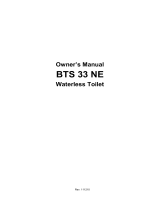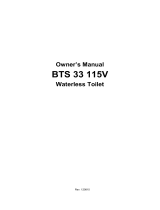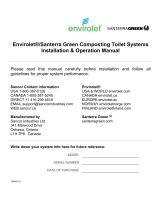Page is loading ...

JW Series
VacuFlush
®
Vacuum
Generator
Vacuum generator
instruction manual
EN
There is a strong, worldwide network to assist
in servicing and maintaining your sanitation
system. For the Authorized Service Center near
you, please call from 8:00 a.m. to 5:00 p.m. (ET)
Monday through Friday.
You may also contact or have your local
dealer contact the Parts Distributor nearest
you for quick response to your replacement
parts needs. They carry a complete inventory
for the Dometic product line.
Telephone: 1 800-321-9886 U.S.A. and Canada
330-439-5550 International
Fax: 330-496-3097 U.S.A. and Canada
330-439-5567 International
Web site: http://www.Dometic.com
Customer service
Dometic is a customer-driven, world-leading provider
of leisure products for the RV, automotive, truck
and marine markets. We supply the industry and
aftermarket with a complete range of air conditioners,
refrigerators, awnings, cookers, sanitation systems,
lighting, mobile power equipment, comfort and safety
solutions, windows, doors and other equipment that
make life more comfortable away from home.
Dometic supplies a wide range of workshop
equipment for service and maintenance of built-in
air conditioners. Dometic also provides specially
designed refrigerators for hotel rooms, ofces,
wine storage and transport and storage of medical
products.
Our products are sold in almost 100 countries and are
produced mainly in wholly-owned production facilities
around the world.
Warranty and product liability
North America and Rest of the World:
Manufacturer’s One-Year Limited Warranty
Dometic Corporation, Sanitation Division warrants to the original purchaser only that this
product, if used for personal, family or household purposes, is free from defects in material
and workmanship for a period of one year from the date of purchase.
If this Dometic product is placed in commercial or business use, it will be warranted to the original
purchaser only to be free of defects in material and workmanship for a period of ninety (90) days
from the date of purchase.
Dometic reserves the right to replace or repair any part of this product that proves, upon
inspection by Dometic, to be defective in material or workmanship. All labor and transportation
costs or charges incidental to warranty service are to be borne by the purchaser-user.
EXCLUSIONS
IN NO EVENT SHALL DOMETIC BE LIABLE FOR INCIDENTAL OR CONSEQUENTIAL DAMAGES,
FOR DAMAGES RESULTING FROM IMPROPER INSTALLATION, OR FOR DAMAGES CAUSED
BY NEGLECT, ABUSE, ALTERATION OR USE OF UNAUTHORIZED COMPONENTS. ALL IMPLIED
WARRANTIES, INCLUDING ANY IMPLIED WARRANTY OF MERCHANTABILITY OR FITNESS
FOR ANY PARTICULAR PURPOSE, ARE LIMITED TO A PERIOD OF ONE YEAR FROM DATE OF
PURCHASE.
IMPLIED WARRANTIES
No person is authorized to change, add to, or create any warranty or obligation other than
that set forth herein. Implied warranties, including those of merchantability and tness for a
particular purpose, are limited to one (1) year from the date of purchase for products used for
personal,
family or household purposes, and ninety (90) days from the date of purchase for products
placed in commercial or business use.
OTHER RIGHTS
Some states do not allow limitations on the duration of an implied warranty and some states do
not allow exclusions or limitations regarding incidental or consequential damages; so, the above
limitations may not apply to you. This warranty gives you specic legal rights, and you may have
other rights which vary from state to state.
To obtain warranty service, rst contact your local dealer from whom you purchased this
product or go to http://www.dometic.com for a dealer near you.
Europe:
Warranty and Customer Service
Warranty arrangements are in accordance with EC Directive 44/1999/CE and the normal
conditions applicable for the country concerned. For warranty or other service, please contact
our Dometic service department listed elsewhere in this manual. Any damage due to improper
use is not covered by the warranty.
The warranty does not cover any modications to the product or the use of non-original
Dometic parts; the warranty does not apply if the installation and operating instructions are
not adhered to and no liability shall be entertained.
Product Liability
Product liability of Dometic Group and its subsidiary companies does not include damages
which may arise from: faulty operation; improper alterations or intervention in the equipment;
adverse effects from the environment which may impact the equipment itself or the direct
vicinity of the equipment or persons in the area.
To obtain warranty service, rst contact your local dealer from whom you purchased this
product or go to http://www.dometic.com for a dealer near you.
Dometic Corporation, Sanitation Division
13128 State Rt. 226, P.O. Box 38
Big Prairie, OH 44611 USA
1-800-321-9886 • Fax: 330-496-3097
www.Dometic.com
REVISION A
Form No. 600345151 7/17
©2017 Dometic Corporation

Components (g.
1
)
Ref. Description
A Inlet tting
B Outlet tting
C Vacuum tank
Refer to complete parts list (packed separately) for additional information.
Ref. Description
D Vacuuum switch
E Vacuum pump motor
F Vacuum pump body
Electrical Specifications
Dimensions (g.
2
)
Ref. Dimension
A 20.125 in. / 511 mm
B 14 in. / 356 mm
C 9.125 in. / 232 mm
Specifications
Materials
Pump body: glass-lled polypropylene
Pump bellows: engineered PP/PE resin
Duckbill valves: EPDM
Vacuum tank and fittings: glass-lled
polypropylene
Installation
General guidelines
Wiring
Note
Two-toilet VacuFlush systems require a vacuum generator for each toilet.
Note
Make sure to connect toilet discharge hose to inlet tting of vacuum generator.
Note
Use two hose clamps for each hose connection (g.
3
B).
1. Vacuum generator must be installed horizontally only.
2. The vacuum generator can be located up to 50 feet (15.2 m) from the VacuFlush toilet,
and 20 feet (6.1 m) from the holding tank or other waste destination.
3. The vacuum generator inlet must not be located more than 6 feet (1.8 m) higher than the toilet
discharge outlet.
4. The maximum head pressure on the discharge of the vacuum generator must not exceed 6 feet
(1.8 m).
5. To minimize standing sewage in discharge hose, position vacuum generator inlet at same level
or lower than toilet outlet where possible.
1. Wire vacuum generator according to diagram below and Electrical Specications in VacuFlush
toilet manual.
2. Pre-wired connectors (if applicable) can be cut off to complete wiring.
3. Use stranded copper wire. Protect wires with grommets or other protective devices at holes
and sharp edges.
4. Do not overfuse. Overfusing the vacuum generator will result in warranty invalidation.
1. Make sure the vacuum generator is properly located before proceeding. Place the vacuum
generator on at surface. Position as needed. Using a center punch, mark the four slotted
holes in the pump feet. Remove vacuum generator.
2. Using a 3/16-inch (5 mm) drill bit, drill the four mounting holes. Use #14 wood screws and
washers to secure vacuum generator.
3. Position pump body (g.
1
F) to accommodate plumbing layout, if necessary, by
loosening four fasteners that hold pump onto vacuum tank, rotating pump body to desired
position, and retightening fasteners.
4. Spin-nut connections on inlet and
outlet ttings allow easy installation
and positioning of hoses. After
positioning inlet tting in proper
direction to accept inlet hose from
toilet, make sure to tighten spin-
nut 1/2-turn past hand-tight with
wrench (g.
3
A).
Installation and plumbing
Caution – Pump
starts automatically.
Turn off power before
making nal electrical
connection or servicing.
A
B
C
D
E
F
1
2 3
A
A
B
B
C
Vacuum testing
1. Prime pump with water before performing vacuum test. If vacuum generator is part of
compost system, make sure discharge hose from vacuum generator is not connected to
compost unit during priming process.
2. POSITIVE PRESSURE TESTING IS NOT RECOMMENDED. JW series vacuum generator is
designed to seal with negative pressure (vacuum), and will not hold positive pressure.
Note
If vacuum generator connects to electronic-ush VacuFlush toilet, refer to VacuFlush toilet wiring
diagram for complete information.
Operation
When a VacuFlush toilet is ushed, vacuum pressure created by the vacuum generator pulls waste
from the toilet to the vacuum generator. The increase of ambient pressure in the vacuum tank
causes the vacuum switch (g.
1
D) to turn on power to the vacuum generator. The vacuum
pump begins to create vacuum and push the efuent in the discharge line to the holding tank
or other destination. After vacuum is restored in the discharge system (about 60-90 seconds,
depending on the installation), the vacuum switch shuts off electrical power, and the toilet system
is ready for the next ush.
Caution!
Vacuum pump starts automatically. Turn off electrical power before servicing.
Warnings
The following statements must be read and understood before installing, servicing and/or
operating this product. Modification of this product may result in property damage.
Dometic recommends that a qualied technician or electrician install or service this product.
Equipment damage, injury to personnel or death could result from improper installation. DOMETIC
ACCEPTS NO RESPONSIBILITY OR LIABILITY FOR DAMAGE TO EQUIPMENT, OR INJURY OR
DEATH TO PERSONNEL THAT MAY RESULT FROM IMPROPER INSTALLATION, SERVICE OR
OPERATION OF THIS PRODUCT.
Notes on using these instructions
Note
Supplementary information for operating the device.
fig.
1
A: This refers to an element in an illustration. In this example, item A in gure 1.
Caution!
Safety Instruction: Failure to observe this instruction can cause material damage and
impair the function of the device.
General safety instructions
The manufacturer will not be held liable for claims for damage resulting from the following:
• Faulty assembly or connection
• Damage to the unit from mechanical inuences, misuse or abuse
• Alterations to the unit without express written permission from the manufacturer
• Use for purposes other than those described in the operating manual
Intended use
The Dometic JW series vacuum generator creates the powerful vacuum of a VacuFlush toilet
system. When the toilet is ushed, the vacuum in the discharge line pulls the toilet contents into
the vacuum generator, which then propels the efuent to a holding tank or other waste treatment
device.
Benefits
Versatile installation. Powerful vacuum pump allows toilet to be located up to 50 ft. (15.2 m) away
and 20 ft. (6.1 m) from holding tank or other waste destination.
Automatic “full tank” shut-down. When installed with holding tank that includes a “full tank” level
indicator, an automatic shut-down relay will stop electrical power to the vacuum generator when
the holding tank level reaches “full.” This prevents holding tank overll which can cause damage
to the toilet system.
Easy maintenance. Two-piece design allows easy access to vacuum tank interior if required.
Model Voltage (DC)
Power Draw
(amp average)
Fuse/
breaker
Flow
(GPM/LPM)
Wire
size
Weight
(kg/lbs.)
VG4-12 12 6 10 5.1 / 19.3
follow local
codes*
15.1 / 6.9
VG4-24 24 3 5 5.1 / 19.3
follow local
codes*
15.1 / 6.9
* For marine applications follow ABYC wiring recommendations.
Specications subject to change without notice.
CAUTION! ELECTRICAL HAZARD
DO NOT CONNECT JW SERIES VACUUM GENERATOR DIRECTLY TO STANDARD
RESIDENTIAL WIRING SYSTEM. JW series vacuum generator operates on 12 V DC or
24 V DC through a 10-amp or 5-amp circuit (see Electrical Specications chart, above).
For residential use, this product must be connected to a minimum 12-amp power
converter with 12 V DC electrical output.
/







